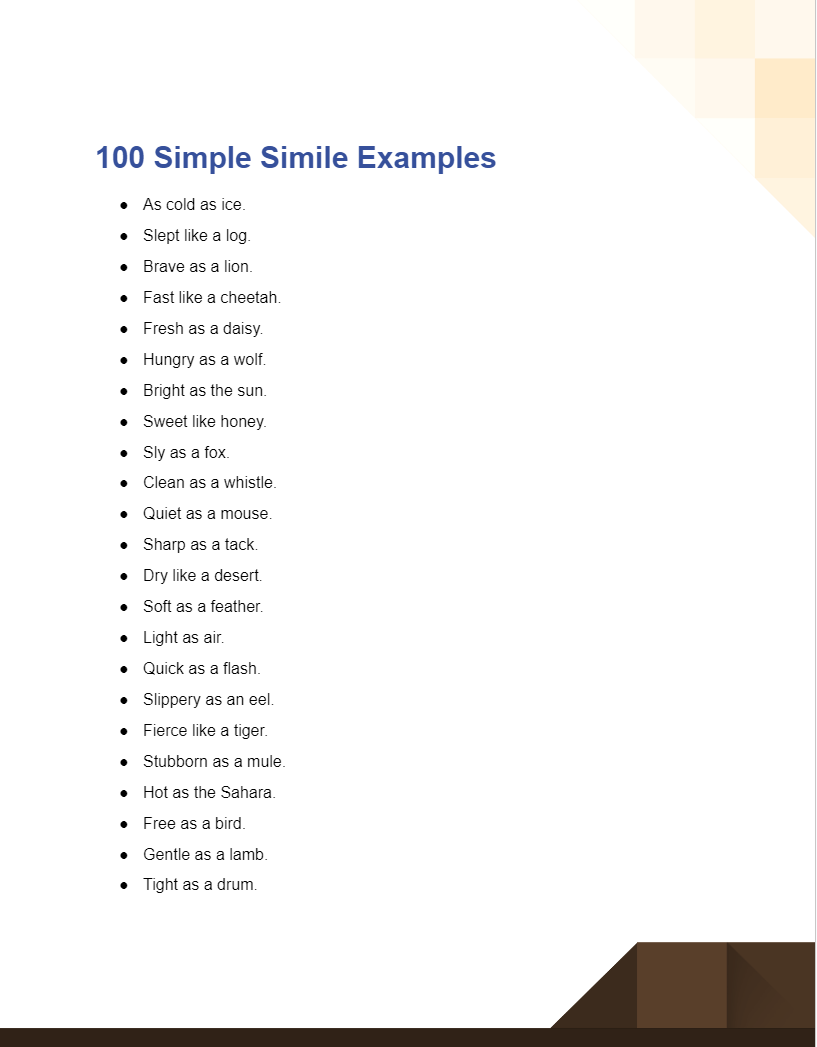99+ Simple Simile Examples
Unlock the elegance of simplicity with our curated list of simple simile examples. While similes often conjure vivid imagery, there’s an understated power in crafting straightforward comparisons. As an essential literary device, similes breathe life into ordinary descriptions, making them relatable and evocative. Navigate through our treasure trove of examples, and arm yourself with expert writing insights and tips to refine your craft. Dive in, and master the subtle art of the simple simile!
What is a Simile for Simple Simile? – Definition
A simple simile is a basic comparison using “like” or “as” that directly relates two unlike things in a straightforward manner. Unlike complex similes, which may require deeper understanding or context, a simple short simile is easy to grasp and often used to make relatable and clear observations in everyday language.
What is the Best Example of Simple Simile?
“She was as busy as a bee.” This simile compares someone’s level of activity or busyness to that of a bee, which is universally understood to be always on the move. The comparison is clear, direct, and easy to understand, making it a quintessential example of a simple simile.
100 Simple Simile Examples

Dive into the art of comparison! Simple similes are the essence of poetic embellishment in everyday language. These easy-to-understand figures of speech compare one thing to another using “like” or “as.” Here’s a list of 100 unique, distinct, and illustrative simple similes to spruce up your conversations or writings.
- As cold as ice.
- Slept like a log.
- Brave as a lion.
- Fast like a cheetah.
- Fresh as a daisy.
- Hungry as a wolf.
- Bright as the sun.
- Sweet like honey.
- Sly as a fox.
- Clean as a whistle.
- Quiet as a mouse.
- Sharp as a tack.
- Dry like a desert.
- Soft as a feather.
- Light as air.
- Quick as a flash.
- Slippery as an eel.
- Fierce like a tiger.
- Stubborn as a mule.
- Hot as the Sahara.
- Free as a bird.
- Gentle as a lamb.
- Tight as a drum.
- White like snow.
- Red as a rose.
- Proud as a peacock.
- Shiny as a star.
- Chirpy as a cricket.
- Rich like a king.
- Wet as a fish.
- Lonely as a cloud.
- Busy as a beaver.
- Green as grass.
- Smooth as silk.
- Precious like gold.
- Witty as a clown.
- Firm as a rock.
- Clear as crystal.
- Float like a butterfly.
- Slow as a snail.
- Fluffy as a cloud.
- Slick as a whistle.
- Blunt as a hammer.
- Strong as an ox.
- Flat as a pancake.
- Deep as the ocean.
- Pure as snow.
- Fresh as morning dew.
- Thin as a rail.
- Neat as a pin.
- Hard as stone.
- Steady as a clock.
- Bright as a diamond.
- Hot as fire.
- Salty as the sea.
- Heavy as lead.
- Blue as the sky.
- Wide as the sea.
- Tight like a vice.
- Thick as thieves.
- Sour like a lemon.
- Dark as night.
- Smooth as butter.
- Light as a feather.
- Cozy as a kitten.
- Old as time.
- Round as a ball.
- Cold as steel.
- Deep as a well.
- Wild like the wind.
- Dull as dishwater.
- Cool as a cucumber.
- Fresh as a mint.
- Silent as the grave.
- Safe as houses.
- Tall as a tree.
- Loose as a goose.
- Pretty as a picture.
- Slick as oil.
- Quick as a wink.
- Blind as a bat.
- Warm as toast.
- Pure as an angel.
- Straight as an arrow.
- Slippery like soap.
- Hungry as a bear.
- Big as a mountain.
- Small as a pea.
- Shallow as a puddle.
- Bitter like quinine.
- Stiff as a board.
- Fit as a fiddle.
- Rich as Croesus.
- Rough as sandpaper.
- Young as the morning.
- As wise as an owl.
- Graceful as a swan.
- Mute as a fish.
- As clear as mud.
- Solid as a rock.
Simple Simile Examples for Kids
Childhood and imagination go hand in hand, and similes serve as an expressive tool to fuel that creativity. These simile examples for kids are tailored for young minds, making comparisons between everyday items and experiences that are familiar and relatable to kids.
- Laughing like a giggling teddy bear.
- Curious as a cat watching a goldfish.
- Eyes twinkling like fairy lights.
- Bouncy as a rubber ball.
- Dreams fluffy as marshmallows.
- Excited as a puppy with a new toy.
- Smooth as a slide in a playground.
- Cheeks rosy like apple candy.
- Gentle as a lullaby.
- Eager as opening a present.
Simple Simile Sentence Examples
Similes have the power to breathe life into your simile sentences by making them more vivid and relatable. The following are uncomplicated simile sentence examples that can be easily incorporated into daily conversations or writings.
- Her voice was as soothing as a gentle stream.
- The day began bright as a freshly polished coin.
- His temper flared up like a struck matchstick.
- She danced with grace, light as a butterfly.
- The baby’s laughter was as melodious as a songbird’s tune.
- His confusion was clear, like fog over a mountain.
- The sunset painted the sky, pink as cotton candy.
- The secret spread fast, like ripples in a pond.
- The child’s enthusiasm was infectious, spreading like wildfire.
- His courage shone bright as a beacon in the night.
Simple Simile Examples for Students
Learning the art of simile for students, understanding through clear, relatable examples is key. The following similes are tailored for a student’s perspective, drawing parallels from their surroundings, academic journey, and personal experiences.
- As organized as a well-labeled binder.
- As challenging as a final exam question.
- Thoughts scattered like loose papers in a backpack.
- As determined as a scholar chasing an ‘A’.
- Friendship strong as a library’s oldest book.
- As refreshing as a break after a long study session.
- Ideas flowing like ink from a pen.
- Memories fading like chalk on a blackboard.
- As precise as a mathematician’s calculations.
- Creativity blossoming like art on canvas.
Can a simple sentence have a simile?
Absolutely! A simple sentence can contain a simile. By definition, a simple sentence has one independent clause, but that doesn’t limit the content of that clause. While the sentence is structurally simple, a simile can enrich its imagery and meaning. A simple sentence with a simile might look like this: “Her eyes sparkled like diamonds.” Here, the sentence is concise and straightforward, yet the simile enhances the description significantly.
How do you Write a Simple Simile? – Step by Step Guide
- Identify the Subject: Decide on the primary object or subject you want to describe. For example, “the rain.”
- Determine the Quality or Characteristic: Think about the specific trait or quality of the subject you want to emphasize. For our example, it might be “the softness of the rain.”
- Find a Comparable Object or Experience: Think of another object or experience that shares the chosen characteristic. For the softness of the rain, it might be “a lullaby.”
- Formulate Your Simile: Combine your subject and comparison using “like” or “as.” For our example: “The rain was as soft as a lullaby.”
- Refine & Simplify: Ensure your simile is straightforward and easily understood. Avoid overly complex comparisons.
- Test It Out: Share your simile with someone else or say it out loud. Does it convey the imagery or feeling you intended?
- Use Sparingly: While similes are powerful, overusing them can make your writing feel cluttered. Choose moments that truly benefit from enhanced imagery.
Tips for Writing a Simple Simile
- Stay Relatable: Use comparisons that most people can understand and visualize. The more universal, the better.
- Avoid Clichés: Phrases like “as busy as a bee” or “as clear as mud” are overused. While they’re understandable, original similes often have a stronger impact.
- Be Specific: The more precise your simile, the more vivid the imagery. Instead of saying “as fast as a car,” you might say “as swift as a racecar on the final lap.”
- Match the Tone: Ensure your simile matches the tone of what you’re writing. A humorous simile might not work well in a serious context, and vice versa.
- Practice Makes Perfect: The more you experiment with similes, the better you’ll become at crafting them. Practice by describing things around you using similes, and soon it’ll become second nature.
- Less is More: Remember, simplicity is key. The beauty of a simple simile is in its clarity and brevity. Avoid over-complicating the comparison.
Remember, a simple simile, when used appropriately, can illuminate a description and make it memorable. The beauty lies in its ability to create vivid imagery with just a few words.


